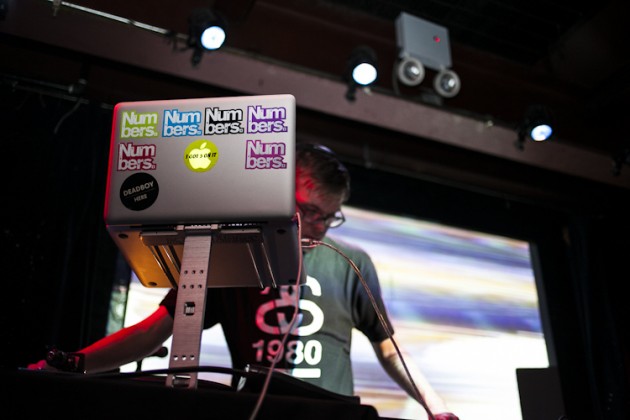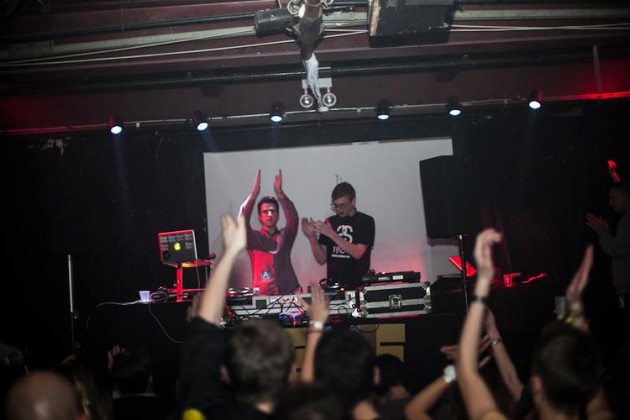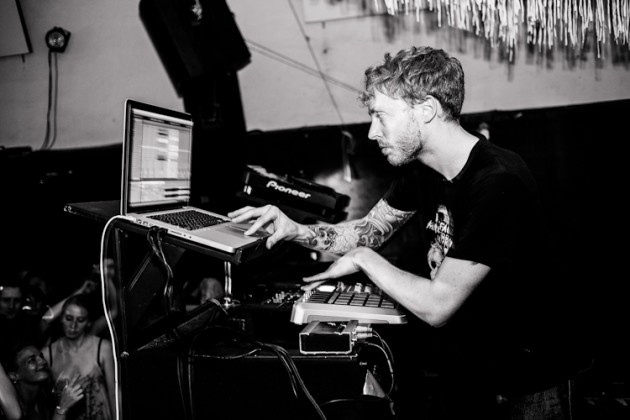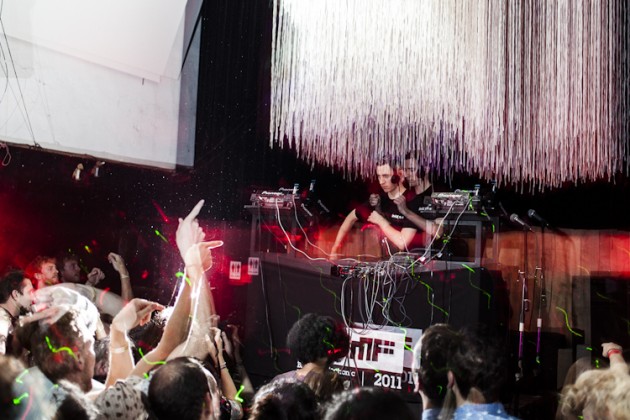All photos by Oliver Correa & Amanda Rohowksy
Last month I had the pleasure of attending my first Stateside festival which, by default, was the best too. But for all of Asheville’s breathtaking scenery, strong sense of community and charming quirks, it took a mere two weeks for Moogfest to slip from pole position, trumped by a minor masterstroke of both efficiency and efficacy that both reaffirmed the ability of multi-venue events to stand shoulder-to-shoulder with the summer mainstays that become cities within themselves, and neatly underscored in the process why electronic music deserves to be enjoying a real moment in the sun. Whereas Moog was a curiously continental affair, drawing upon a eclectic mix of genres and keeping the impetus on live performance, the Brooklyn Electronic Music Festival was comprised largely of DJs, and had American fingerprints all over it.
This was notable across the board: you see it in the 808 rolls of Nadastrom and the rough-edged club bounce of Dubbel Dutch; representation of LA’s multifaceted beat scene was evident in the Fade to Mind and Friends of Friends stages, the music respectively slathered in Technicolor gloss and shrouded in haze; there was some 11th hour cake icing by way of local disco vets Metro Area and The Rapture’s Vito & Druzzi, as well as the surprise announcement of an All Ages stage in a commendable move that pays testament to promoters MeanRed’s willingness to adapt to the swelling interest of a younger audience. Two of Friday night’s headliners herald from the UK, but Photek currently resides in Los Angeles and Gold Panda falls somewhere in between the chime of Baths and lurch of XXYYXX. On balance, the fifth edition of BEMF was a homegrown affair, liberally cherrypicking artists from across the country and squeezing them into a tiny corner of Williamsburg, allowing for painless, fluid transition between an array of different scenes and styles. So naturally what did I do? Stick precisely to what I know, dividing my time across the entire weekend of music between two rooms that were a block apart. Utterly shameful, but utterly glorious.
One novelty that stuck out about Moogfest, especially with Richie Hawtin’s enthralling set, was the lack of reference points. Beyond a surface knowledge of the type of music on offer, I was sailing largely through unknown waters. Walking into the Numbers. showcase at Public Assembly to the tumbling breakdown of Sunship’s ‘Try Me Out’, the contrast could not have been more apparent – Deadboy was unleashing a barrage of ’99-’01 UK garage stormers, kicking off proceedings in a supremely familiar fashion. Having feared I had missed the fellow Londoner’s set altogether, it was a welcome surprise to not only catch the man in action, but be treated to half an hour of unearthed garage treasures, capped off by the monstrous 1-2 sucker punch that was Wookie’s remix of Sia’s ‘Little Man’ followed by Doolally’s ‘Straight From The Heart’. By 10:30 the venue was heating up and the floor was quickly filling with a cluster of early revellers who greeted each soaring vocal and shuddering bassline with arms aloft. On that note, the sound in Public Assembly was absolutely phenomenal, delivering sternum-rattling power without losing clarity or once tipping into uncomfortably loud levels, doing full justice to Deadboy’ no-nonsense display, allowing him to pummel the rapidly filling dancefloor with full force. It was a shame to see it wrap up, but, 45 minutes later than expected, the venue headliner was ready to roll.
Omar-S is, to paraphrase Winston Churchill, a riddle wrapped in a mystery underneath a fisherman hat. For starters, no-one can really deduce whether his moniker is meant to be hyphenated or not, but that’s by the by. Despite records to his name(s) dating back to 2003, the bulk coming out on his own FXHE label, it wasn’t until the turn of the decade that he began the rapid acceleration from mysterious Detroit curio to a name that most people would gladly place aside Moodymann and Theo Parrish as a leading purveyor of soulful house/techno that manages to be at once sharp and dubby, groovy and formless, jerky and smooth and – crucially – both uplifting and faintly menacing. He commands such respect (and fear) that the photographer pauses for a thumbs up from Omar before shooting him; I guess his reputation for not being the most outgoing of chaps precedes him. By the time he takes to the decks (no laptops here), the front room of Public Assembly is absolutely rammed, feeling as if the capacity for the entire venue has wedged into half the space. There’s a tangible electricity in the air, and that goodwill helps carry the momentum in spite of Omar’s somewhat haphazard control of the energy or when his unhurried and infrequently clumsy mixing jars the flow.
That said, the tunes speak for themselves, and in just over two hours he manages to weave a path through a diverse melange, segueing in the first hour from Latin-flavoured grooves to a bizarrely cogent meld of space disco synths and rubbery basslines, before driving hard through Chicago jack and into thumping garage house and finally wrapping up on loopy disco edits. It was extremely well crafted, if a tad frustrating at times, but irrespective of the direction he took, the whole journey felt tangibly his, displaying throughout his signature calling card: honesty. At no point did it feel as if Omar was compromising his own particular vision as he launched wave after wave of deep, emotional electronic wares. That’s not to say it was an introspective set, nor did he shy away from deploying some 24ct belters: he brings out two of the finest cuts in his arsenal – ‘Wayne Hill County Cop’s’ and ‘Here’s Your Trance, Now Dance!!’ – but chooses to keep the Detroit Mix of 2012 sleeper hit ‘Tonite’ in the bag, presumably on the basis that it would have stuck out like a sore thumb. In the final stretch Omar tightened the reigns, bringing with him a rise in energy that crests, bang on 1am, with the unflappable 1987 classic ‘Can U Dance?’ which wraps things up with a bang – not that he pays much heed, trundling off stage apparently oblivious to the rapturous applaude. Nitpicking aside, it was an assured and formidable showing from an underground heavyweight, teeing up Jackmaster very nicely indeed.
Jackmaster, much like Omar-S, has been a success story of recent years, which makes it easier to overlook the near-decade spent slowly plying his trade on the decks and building a reputation for cross-genre pollination and genuine passion that eludes many of his contemporary peers. With the launch of Numbers. records in 2010 momentum picked up and he capitalised on the accrued groundswell of support by releasing one of the standout Fabriclive CDs last year; in a similar vein to Omar’s 2009 Fabric 45 compilation, his first commercially available mix brought a wider audience to recognise his talent. Whether a conscious nod to New York’s heritage or a personal predilection for the stuff (likely a bit of both), the immaculately coiffured Glaswegian set about warming up the crowd with a good half an hour of disco and funk; well, so long as you can call the likes of Sister Sledge, Storm Queen and a stripped-down edit of Talking Heads’ ‘Psycho Killer’ mixed into Todd Terje’s ‘Inspector Norse’ (a bona fide song of the year contender) “warming up”.
It is difficult in a sense to critically evaluate a personal favourite, be they DJ or band, especially when highly accustomed to both their style and selection, but the change of scenery made it an interesting experience to witness. Bodies were limber and and a heady club atmosphere had settled inside the bar, but fluctuating volume levels – a marked decline from the muscular heft at the beginning of the night – began to break the spell, if only fractionally. It was deftly mixed and expertly strung together, but it wasn’t hard to detect an impatience amongst small pockets of the crowd, who may have been coming to see Jackmaster for his hit machine reputation and not the depth of his musical knowledge. As disparaging as that may sound to the assembled throng, the airing at 2am precisely of Julio Bashmore’s ubiquitous ‘Au Seve’ perhaps highlighted why; a clarion call of sorts, it delineated a shift in approach from one side of Jack to the other. The intricately unwinding ball of yarn had been lit and what followed was something akin to a dancefloor greatest hits, a neat encapsulation of the porous nature of the nebulous ‘UK Bass’ scene, all the more thrilling for its total lack of boundaries. In little short of an hour we had been treated to a selection that spanned Destiny’s Child to Bicep, Ralphi Rosario to Prince, Ludacris to Jamie xx and married ‘Mercy’ – that’s the GOOD Music version, not the Boddika one – to ‘Midnight Request Line’ in an unintentionally poignant reminder that, in pop cultural terms at least, Croydon murk is no longer a million miles away from Kardashian glitz. It was as triumphant as expected, capping the night perfectly, and made me feel a bit daft for ever doubting the man.
Following the previous night which seemed angled directly at me, I arrived on Saturday with two hours spare to check out something different. Public Assembly opened doors nice and early, so it seemed a no-brainer – from the egoless bouncers through to the efficient bar staff, factoring in the extremely adept sound engineers and even the nice chap who fetched me a spare pair of earplugs, the venue was rapidly becoming a firm favourite after three visits [full disclosure: Beats Per Minute’s own CMJ showcase was held at PA] and any initial assumptions that I would be starting my night with a decidedly chillwave drift were knocked askew by the introduction of clattering kickdrums seemingly lifted straight from Homework-era Daft Punk as Lazy Brow took to the wheels of steel. His Friends of Friends roster at BEMF boasted a handful of the hottest Los Angeles scene darlings, and the label itself has garnered a reputation built on diversity, courting artists such as Daedelus and DJ /rupture that have become synonymous with an innovative approach to production and performance.
To begin with, Lazy Brow’s selection mirrored this open-ended approach, alternating between sticky funk and vocal-led tech house and infrequently lacing the set with more recognisable heaters. The mixing was a tad bumpy in places, but with a purely vinyl approach it’s harsh to criticise, and the man proved to be the sole jockey all weekend who drew exclusively from wax, which further engendered the notion that I had stumbled upon a real surprise package. Alas, the facade of unfamiliarity gave way before too long: having seemingly kept us guessing for long enough, loosening legs and unwinding necks with close to a solid hour of deeply entrancing grooves, the FoF bossman switched gears and adopted a role I was considerably more accustomed to, dropping slammer after slammer in dizzying succession – that both Scuba’s ‘Adrenalin’ and the Claude VonStroke remix of Girl Unit’s indelible ‘Wut’ were given extensive room to play out probably tells you all you need to know about the calibre of cuts. No complaints here though, as I managed to get the best of both worlds, ducking out of the heaving crowd before Salva took to the stage at midnight to expand my horizons (if only narrowly) by sidling through to the backroom of Cameo for the Deviation showcase, the strains of Roy Davis Jr’s 1996 hit ‘Gabriel’ floating out the entrance serving only to validate my decision.
The venue was admittedly an an odd shape, far too boxed-in to properly accomodate the sound desk plonked in the middle and with the public bathroom situated behind the decks, creating an odd imbalance where the crowd clustered around the bar at the back and barely filled the space up front, but the sound was bold and inviting, and area boy Drew Lustman aka FaltyDL had drawn a sizeable gathering. Lustman had the dubious honour of being the lone artist I caught all weekend who stuck rigidly to the allotted hour (Lazy Brow enjoyed nearly double the stated runtime), requiring from the off a nimble touch on the buttons – well, I say ‘buttons’, although the photo above appears to point to Ableton. But if time constraints were bearing upon him they appeared not to show as he eased into the set with a relaxed approach, manipulating the mix at will and gliding across percussive house with laser synth lines and sharp hats that cut through the rolling funky rhythms underfoot. He wasn’t afraid to plumb deeper territory, as Pépé Bradock’s breezy ‘Deep Burnt’ demonstrated, but the energy surged through the packed dancefloor as he pushed his way through brief spell of 90s piano-stabbing revivalism by way of Lone, Scuba and Midland’s prime edit of Caribou’s ‘Sun’ and out into harder territory that leant as much on the aggression of grime as it did the uplift of house. By slightly unfortunate coincidence, Lustman managed to air at least three tracks that had been played out the night before, and while I was more than happy to hear S-Type, Hardrive and MikeQ again, it tempered the excitement fractionally, further softened by the rote fluidity of the laptop-aided mixing. Still, it was heaps of fun and the vibe remained strong throughout as Lustman mapped out a wide array of influences over a relatively limited timeframe. On a personal note, as someone who copped the To London EP all the way back in May 2009 and remained hooked on the complexities of IDM-flecked dubstep that abounded at the time without any real knowledge of the producers behind it all, it was wonderful to find FaltyDL all these years later in a supremely playful mood, sashaying to Kid Creole & The Coconuts and running his fingers through the billowing decorative piece overhead.
Due in part to the combination of extensive equipment change, unenviable schedule conflicts (Nicolas Jaar, Shlohmo and XXYYXX all simultaneously vied for attention on the 1am mark) and the considerable reduction in tempo continuing for a good 15-20m, the crossover between FaltyDL and the following man left a sag in atmosphere; but true to form, it didn’t take much time for Radio 1 golden boy, Deviation don and all-round badman Benji B to flip the fading energy levels 180˚ and whip up a frenzy. Indeed, beyond that initial drop off, Benji displayed over 90m precisely why he garners worldwide acclaim as a man who has successfully subverted the staid commercialism of the BBC, armed only with his encyclopedic knowledge, roguish charm and, more pertinently, boundless passion for beat-led music of all styles.
These three traits manifested themselves across the set: unlike many of his peers he eschewed the tendency to lean on more current fare, capably twinning the propulsion of escalating tempo with an added dimension of back-to-front chronology, worming his way from drum machine jams both vintage (Man Parrish, Adonis) and very much contemporary (Helix, Lil Silva). His dexterity was something to behold as he got the whole venue jumping, utilising the full gamut of available tools – from USB to white label wax – and invoking amongst some members of Cameo’s crowd the kind of dancing likely not seen since the glory days of the old skool electro he was channeling. Benji’s charisma shone through once he hopped on the mic, repeatedly praising New Yorkers for their vitality and labelling the city his second favourite (behind London, natch), before beckoning to the sound guys to properly engage the subs as he steamrolled through a reload of Bok Bok’s still-monstrous ‘Silo Pass’ into his final section, and perhaps the highlight of the entire festival: half an hour of furiously paced, rumbling hip-hop and trap that laid waste to the crowd. ASAP verses fed into Clams originals, Africa Hitech’s frenzied vocal leads rode roughshod over TNGHT’s thunderous bass drops and, as the sound quibbles subsided and the venue’s sonic potential fully realised, the intermittent flickers of frustration on Benji’s face transformed into a satisfied grin. His own dubplate of Nas’ ‘The Don’, which hilariously peppers the original track with snippets of his own name, segued into Slum Village’s ‘Fall-N-Love’, a tasteful nod to Benji’s Dilla fanboyism, before he wrapped up with The Mary Jane Girls’ 1982 smash ‘All Night Long’. If that makes for an exhausting read, well, it made for a shattering ride in the flesh; indeed, the only real downside to Benji’s scorched-earth blitzkrieg was that it had completely wiped me out and, as such, severely dented my enjoyment of the closing DJ of the night, so much so that I feel it unfair to evaluate Pearson Sound in quite the same manner. He was as engaging as ever, snaking polyrhythmic drum patterns through polyrhythmic drum pattern into an impressive fashion, but I sadly could only last for around quarter of an hour before bottoming out and calling time on my weekend in Williamsburg.
Now, then, to the bigger picture: how did Brooklyn Electronic Music Festival stack up as a whole? Well, if you’ve made it this far, you can probably guess my opinion tilts into more positive territory than negative. To be perfectly honest, the only criticism that can be viably levelled was that the music I heard was similar at times, but I’d put that down either to the porous nature of the current electronic scene or my comparatively narrow intake. There was comfortably enough variation to keep each sets scintillating in its own right, with only half a dozen tracks getting repeat plays over roughly nine hours of airtime. There’s a fair argument that Saturday boasted a stronger bill than Friday – likely necessitated by the weekday work schedule of international artists such as Nicolas Jaar and Benji B – and it was a shame that cluttered congestion between 1-3am on the second day ruled out the possibility of catching more than a couple of the marquee bookings for risk of losing re-entry, but again, it’s more than excusable as the live performances at some venues almost certainly impinged on the viability of earlier start times.
But truthfully, short of finding ‘faults’ in the most pathetic of places, the festival was fantastic. Without exception, every person I spoke to was affable and the general crowd demeanor considerate and relaxed, lending the entire event an atmosphere of joviality which belied both the consistently high energy levels and very genuine sense of appreciation on display throughout; people were not afraid to get seriously stuck in and all six DJs I caught were given the reaction usually reserved for hometown heroes. The calibre of bookings may not have been as broad as some rival electronic weekenders, granted, but at the same time the pitfall of inconsistency was neatly sidestepped. The sound was as close to flawless as one could hope for at a multi-venue venture and despite the curfew pushing close to sunrise on both nights, things never threatened to devolve into the kind of piecemeal shambles I’ve experienced with similar shebangs. That I only caught around 1/8th of the programming speaks volumes to the strength in numbers and how efficiently it was run. With the all-round buoyant atmosphere bolstered by the friendly folk found behind the scenes, in the venues and on the dancefloors, an efficient and fluid style of management and, pivotally, six stellar sets pumped out over two exceptionally impressive rigs, it’s hard to see BEMF as anything less than an unmitigated success on every level. It almost undoubtedly lays claim to the best inner-city festival I’ve attended, and moreover ranks as one of the best electronic events full stop. Book me for next year, yeah?







